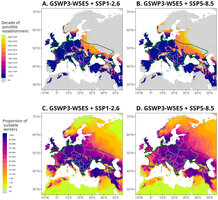~ecology-news-biolog | Bookmarks (445)
-
Shorter and warmer winters may expand the hibernation area of bats in Europe
The ambient temperature has a profound impact on the physiology and behavior of most species. In...
-
How are they biting? High-speed video reveals unexpected jaw movements in reef fish
Some reef fish have the unexpected ability to move their jaws from side to side, biologists...
-
Possible evidence found of cuttlefish waving to each other as a form of communication
Sophie Cohen-Bodénès and Peter Neri, neuroscientists at École Normale Supérieure, in France, report possible evidence of...
-
Gorilla study reveals complex pros and cons of friendship
Friendship comes with complex pros and cons—possibly explaining why some individuals are less sociable, according to...
-
Rare grasshopper thought extinct rediscovered after 40 years
The Monte Gordo grasshopper (Eyprepocprifas insularis) has proved to be a rare and elusive species: its...
-
Discovery suggests that red algae use colors for inter-species communication
Some red algae exhibit structural color that gives their growth tips a blue hue and the...
-
Mixing fungicides and herbicides alters butterfly survival and reproductive success in farmlands
Intensive farming is one of the biggest factors contributing to biodiversity loss. While prior research has...
-
Ancient poems tell the story of charismatic river porpoise's decline over the past 1,400 years
Endemic to China's Yangtze River, the Yangtze finless porpoise is known for its intelligence and charismatic...
-
Why whale urine is so important to life in the sea
Even biologists only capture a glimpse of the lives of whales. There are still many species...
-
How the loss of experienced individual elephants stops knowledge transfer between generations
A new study has revealed how the loss of experienced individual elephants stops the knowledge transfer...
-
Scientists develop antivenom that neutralizes the neurotoxins of 19 of the world's deadliest snakes
By using antibodies from a human donor with a self-induced hyper-immunity to snake venom, scientists have...
-
Intensifying farmland can sometimes be worse for biodiversity than agricultural expansion, study finds
The intensification of existing farmland can sometimes be more harmful to local biodiversity than expanding the...
-
AI system targets tree pollen behind allergies
Imagine trying to tell identical twins apart just by looking at their fingerprints. That's how challenging...
-
Not in the mood: Mercury messes with songbirds' mating game
Before they can fight to survive, some endangered songbirds are losing their groove and being robbed...
-
Saving the kākāpō from 'crusty bum': Study identifies bacterial culprits
Relief may be in sight for kākāpō affected by an extremely painful disease, thanks to a...
-
Long-term field experiment shows combined approach can maximize benefits of grassland restoration
Results from a long-term field experiment shed new light on how grasslands can be restored for...
-
Invasive rats and rainforest mammals are sharing gut microbes as urban areas grow
As urban development continues to creep further into Earth's oldest and most diverse rainforests, a Swansea...
-
Act now or wait centuries: Marine restoration success hinges on immediate intervention
Marine habitats are facing unprecedented threats, with 66% of coastal areas already altered and degraded. Bottom-contact...
-
Rhythmically trained sea lion Ronan returns for an encore—and performs as well as humans
Animal research on biomusicality, which looks at whether different species are capable of behaving in ways...
-
Satellite data and DNA reveal 50-year decline in Greek mountain tea diversity
Increased vegetation growth in European mountains, driven by climate and land-use changes, reduces the genetic diversity...
-
Sea otters benefit from prey boom triggered by loss of ochre sea stars
New research led by Monterey Bay Aquarium reveals a surprising ripple effect in coastal ecosystems: the...
-
Palatable versus poisonous: Scientists reveal how bats learn to identify which prey is safe to eat
Scientists at the Smithsonian Tropical Research Institute (STRI) found that the fringe-lipped bat, known to eavesdrop...
-
Bringing farms back to Chernobyl-affected lands: New protocol offers hope
Thousands of hectares of Chernobyl-affected farmland, long deemed too dangerous for cultivation in northern Ukraine can...
-
Microbial research suggests that biodiversity does not always increase ecosystem stability
Although many conservationists believe biodiversity is intrinsically valuable, the protection of biodiversity has also been argued...












